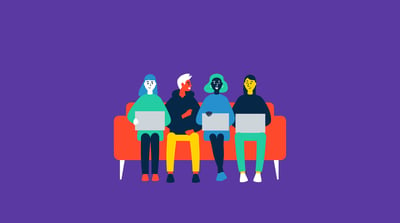May 28, 2021
 by Ashwini Dave / May 28, 2021
by Ashwini Dave / May 28, 2021

Web accessibility implies giving everybody access to the same information irrespective of the impairments or disabilities suffered by them.
With the internet emerging as a primary source of information, entertainment, communication, and e-commerce, one can no longer undermine the importance of web accessibility for users with disabilities or special needs.
Even the United Nations has declared internet access a basic human right. Still, most of the websites remain inaccessible to people with disabilities, as they are designed without keeping their needs in mind.
Web accessibility means that websites and digital tools must be designed and developed in a way that people with disabilities can use them without any hindrance.
According to the World Bank, over a billion people experience some form of disability, corresponding to 15 percent of the world’s population. A disability can be understood as any condition of the body or the mind that makes it difficult for the person to carry out certain activities.
Four loosely grouped types of disabilities have been identified for web accessibility. These include:
Furthermore, there are three modes of disability: permanent, temporary, and conditional or situational, when you cannot do something because of a specific situation you find yourself in, such as a slow internet condition.
Web accessibility also impacts people with temporary disabilities, like someone who has broken an arm, or situational limitations, such as when a person is unable to listen to audio, owing to a lot of background noise.
Senior citizens tend to have accessibility issues associated with advancing age. An aging population means this number is only going to grow, presenting a challenge and an opportunity for businesses with a digital footprint. For instance, hearing and sight are known to become poorer with age.
Yet, these older people with disabilities often have high disposable incomes and leisure time. Seventy-one percent of disabled customers with access needs click away from a website that’s difficult to use. It also found that a large percentage of customers who clicked away had high spending capacities, and 82 percent of users with access needs said they would spend extra if websites were more accessible.
Besides the cost of business, not making your website accessible for everyone can have you sued for digital discrimination. In many countries, it is illegal to discriminate against people with disabilities while selling a product or service.
In the US, the accessibility requirements are listed in the Americans with Disabilities Act. Several lawsuits have been filed against companies, including Netflix, to make their content accessible to everyone.
To make the Internet a public and inclusive place, the W3C Web Accessibility Initiative (WAI) has developed technical specifications, guidelines, techniques, and supporting resources that describe accessibility solutions. For instance, the Web Content Accessibility Guidelines (WCAG) 2.1 define how digital services, tools, and content can be made more accessible to people with disabilities.
Many organizations rely on web content management software to consistently apply these guidelines across large websites. Modern WCMS platforms often include built-in accessibility checkers, template controls, and plug-ins that help designers meet Web Content Accessibility Guidelines standards without needing to code every page manually.
The internet is an essential resource in almost every aspect of life. In 2020, especially, it emerged as a lifeline, keeping the world connected in every way. The high rate of digital adoption in the past year has revolutionized our lives.
Still, a significant percentage of the world's population cannot use the Internet properly owing to accessibility barriers. Ensuring web accessibility provides equal access and equal opportunity for the disabled, helping them participate more actively in society.
Website accessibility is important for many other reasons, such as:
It is often thought that accessible sites benefit only a small percentage of people and consume a lot of time and effort. However, nothing could be further from the truth. We all may experience some sort of temporary disability at some point in life.
For example, if someone slips and breaks their wrist, they may not be able to use the mouse to navigate my PC for a few days. Or if someone has a migraine, poor contrast on a site might aggravate the problem. Besides, all of us are aging during the era of the internet, and our sight, hearing, and dexterity will eventually be impacted.
Creating an accessible website allows users to access your content despite any of the disabilities mentioned above. In this section, we have identified five web accessibility needs that must be addressed for an impactful web design.
The internet consists of information presented in various formats: graphics, video, audio, animation, or text. However, users have shown an increased preference for videos and podcasts in recent years, making our web content experiences both visual and auditory. But some individuals have different auditory needs, and it is imperative to cater to their requirements while designing your website.
Before discussing strategies for improving accessibility for individuals with auditory disabilities, we must first understand the disabilities. Deafness is generally considered to be a complete loss of hearing. However, many individuals suffer from functional hearing loss, which could be mild, moderate, severe, or profound. We have identified three categories of auditory disabilities below.
While sight and hearing are more discussed, this is the category representing the maximum number of computer users. Cognitive disabilities can be functional or clinical. Functional disorders focus on activities that impact an individual’s day-to-day life. Some examples include:
Clinical disorders vary in severity and include:
For website developers, it’s best to think about cognitive disorders from a functional point of view to remove the barriers to accessibility and enhance user experience. One of the most important tips to make your website accessible for people with cognitive disabilities is following good design practices like:
Mobility impairments come in a lot of forms that may or may not be permanent. For instance, you might not be able to use your wrist or hand for a few days due to a fracture. Even typing for long hours can often lead to pain and cramping, making it difficult to use digital devices. Due to arthritis and aging, limited mobility also makes it difficult to type on a keyboard or use a mouse. Some people also lose motor coordination skills and muscle control with age or trauma, making it challenging to handle digital devices.
Many users with temporary or permanent mobility disabilities make use of assistive technologies like screen readers. What is essential is to realize that many of these tools rely on keyboard accessibility. Therefore, your website should be designed to maximize keyboard accessibility so that assistive devices can work properly.
According to Trace Research & Development Center’s Photosensitive Epilepsy Analysis Tool: “Photosensitive seizures can be provoked by certain types of flashing in web or computer content, including mouse-overs that cause large areas of the screen to rapidly flash on and off repeatedly.”
Epilepsy is a common photosensitive seizure disorder. Photosensitive seizures may be triggered by flashing lights, images, and repetitive patterns. For instance, video content on the web computer games might include unsafe flickering, colors, or high-contrast patterns, all of which might trigger seizures.
Additionally, nausea, shaking, and vomiting blood may also happen as an adverse physical response to flashing, flickering, and blinking. In 1997, children watching a Japanese cartoon with an animated “virus bomb” suffered these reactions and had to be rushed to an emergency room for treatment.
According to Prevent Blindness America, 53.2 million Americans aged 45 or older have some form of visual impairment. For understanding web accessibility standards, we may define two types of visual needs.
While complete blindness affects a small percentage of users, UX designers must follow an inclusive approach to make their pages accessible for the visually impaired.
Creating accessible websites is helpful from both business and user perspectives. UI/UX designers must follow web accessibility guidelines to create an inclusive World Wide Web and ensure an inclusive user experience. Besides following the basic design principles, you can use plug-and-play software to make your website accessible, legally compliant, and inclusive. Below, we've listed four popular solutions to keep your website accessible for all.
Closed captioning services providers provide a visual aid to videos in the form of subtitles by integrating transcribed text from dialogue and sounds as they happen. The service was initially designed to help the hearing impaired understand the spoken words and music on television shows and movies, but it can help other people with situational disabilities.
You can find professional closed captioner services for both real-time and pre-recorded videos. G2 lists the best closed captioning service providers and helps you compare products to choose the best closed captioning software for your content.
Screen magnification software can help viewers manage eye fatigue, maintain good posture, and keep a good viewing distance when used for teaching. It is also a great tool to use in your website to enable people with visual difficulties to access the same content as everybody else. For instance, Microsoft offers a Magnifier tool on Windows 10 that can be used to make a part, or all of your screen, bigger so you can see words and images better.
Screen readers are software programs that enable blind or visually impaired users to read the text on the computer screen using a speech synthesizer that reads the text aloud. Some screen readers also communicate data using a braille display. Many screen readers are available for use with personal computers running different OS types, like Linux, Windows, and Mac, IOS, Android, and more.
However, different screen readers incorporate different command structures, but they support several speech synthesizers. Many free screen reading software are available, like NVDA (for Windows) and Apple VoiceOver (for iOS).
Voice recognition software can be used to convert spoken language or audio into text by leveraging speech recognition algorithms. It is helpful for people with hearing disabilities or motor issues, making it easier for them to access your content by converting audio and video files into text. Voice recognition software also helps companies improve business communication by translating and documenting information using AI-based technologies.
Good voice recognition software not only includes several vocabularies and language recognition patterns but also the ability to create and share converted text and capture information on multiple devices. You can compare the best voice recognition software by top service providers to choose the best fit for your content.
Website accessibility is important from both a business and humanitarian point of view. It makes the World Wide Web open to everyone, providing equal opportunities and access while also creating an inclusive environment.
Unfortunately, many websites continue to ignore the requirements of the disabled, which is why some countries have made it a legal requirement to follow the website accessibility guidelines laid down by W3C. If you’re a UI/UX designer, make sure that you consider the needs of the disabled to give your content a wider reach and accessibility.
Ashwini Dave works as a digital marketing expert with Acquire. She is a free soul and adventurous scholar who enjoys spending time with her loved ones as well as listening to music and watching or playing sports. She loves the ocean and is a thrill-seeking traveler who looks at life as a work of art.
Artificial intelligence (AI) has quickly become integral to our lives. From auto-generated...
 by Dekel Skoop
by Dekel Skoop
“You guys, Taylor was such a boss today at the networking event, we were manning our review...
 by Alexa Drake
by Alexa Drake
Workplaces today are becoming more diverse than ever before, bringing together a rich tapestry...
 by Wendy Wang
by Wendy Wang
Artificial intelligence (AI) has quickly become integral to our lives. From auto-generated...
 by Dekel Skoop
by Dekel Skoop
“You guys, Taylor was such a boss today at the networking event, we were manning our review...
 by Alexa Drake
by Alexa Drake


